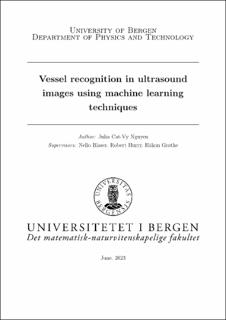| dc.description.abstract | Purpose: Ultrasound is an imaging modality that is commonly used during cardiovascular surgeries globally. The purpose of this thesis is to investigate how machine learning techniques can be used to identify vessel properties and probe orientation in cardiac ultrasound images. The ultimate goal is developing a machine learning algorithm that can automatically recognize vessels in the region of interest with high mean average precision, identify vessel orientation, and run in near real-time. Method: This thesis present a thoroughly data exploration of ultrasound images acquired from a multicenter study. A pilot study of three different object detection models; Yolo, RetinaNet and EfficientDet, was done to find the best model fit for the dataset in the thesis. The three object detection models were trained, tuned and evaluated on the ultrasound data. The object detection model that performed the best after the pilot study was explored further. Yolo outperformed the other models and was therefore chosen as the object detection model for the final study. To overcome the dataset's class imbalance and size problem, data augmentation, resizing and upscaling of the ultrasound images were employed. The resulting data was used to train multiple yolo models with varying hyperparameter tunings. Model selection was then performed on these trained models, and the final model was evaluated on test data. Results: The final model achieved an overall mean average precision at 50\% at 71.77\%. The vessel orientation achieved a mean average precision at 64.6\% for the longitudinal orientation and 75.8\% for the transversal orientation. The model found it easier to locate the aorta compared to the anastomosis, which proved to be more challenging. The speed of the inference of all of these task was 5.6 milliseconds. Although the overall mean average precision was lower than the objective in this thesis, the model excelled in terms of speed. Conclusion: In conclusion, this thesis explored the application of machine learning techniques on ultrasound data for vessel recognition and orientation. Although the final model did not improve the state of the art, the research from this master thesis can serve as a starting point for future reasearch in the field. It represents pioneering work in utilizing a multicenter dataset for machine learning on ultrasound images, providing valuable groundwork and shedding light on the feasibility and potential of machine learning in intraoperative ultrasound. | |
